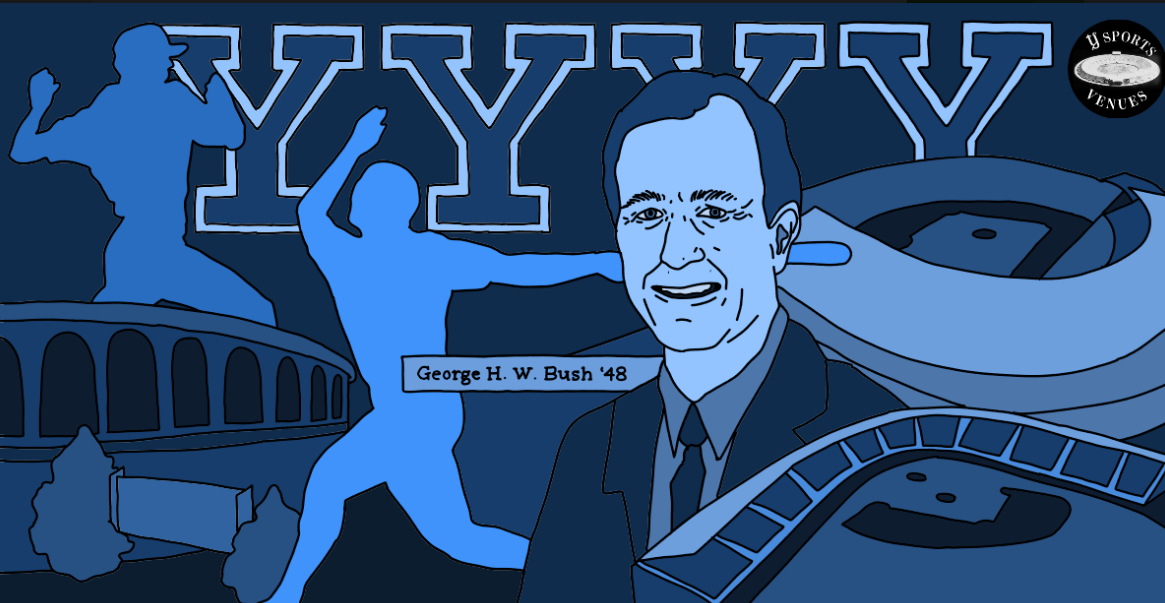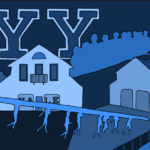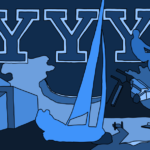Behind the Venue: Bush Field, a historic stadium with a new name
Originally built on the site of an apple orchard with only a handful of bleachers, Bush Field has since risen from its humble beginnings and evolved into a collegiate baseball cathedral, having played host to some of the sports’ most renowned stars in years past.

Anasthasia Shilov, Illustrations Editor and Zully Arias, Production and Design Editor
“Behind the Venue” is a series of feature-form articles that dives into the history, character and most memorable moments of Yale’s various athletic forums — from stadiums and fields to pools and boathouses. While not all articles in the series will resemble one another, all attempt to take a deeper look into how these places came to be and how they have fared over time. This article is the 15th and final in the series.
Concrete arches stand atop its illustrious grandstand. A small, cramped concourse sits beneath, its interior wall peppered with plaques commemorating the greats that stepped foot here years before. The area behind home plate is inlaid with blue, fold-down box seats. Aluminum bleachers emerge higher up in the stands, culminating in a rearmost row of wooden seats that have remained a permanent fixture since construction first took place nearly a century ago. A tiered pavilion littered with picnic tables is situated in the right-field corner. A clubhouse and bullpen sit in left. Pine trees, shrubbery and a chain-link outfield fence surround the 35-foot manual scoreboard in centerfield, smack dab in the middle of the batter’s eye.
The George H.W. Bush ’48 Field, formerly known as Yale Field, has been the home of Yale baseball since the early 20th century. Once a literal open field with only a handful of bleachers to its name, Bush Field has since risen from its humble beginnings and evolved into that of a collegiate baseball cathedral, having played host to some of baseball’s most renowned and esteemed stars in years past.
The early history of Yale Field: from apple orchard to stadium
In 1862, several decades after the first written accounts were made of baseball’s emergence in America, a group of Harvard freshmen banded together to establish what was then referred to as the “’66 Baseball Club.” When the club reached some semblance of organization its members sent out challenges to different colleges, and according to an 1888 story in the Harvard Crimson, one of the groups that received a challenge to compete was the Yale class of 1886. While Yale did not yet have a baseball team at that point, the Bulldogs replied that they hoped to field a team in the immediate future. Unbeknown at the time, the Crimson’s casual bid for competition galvanized the formation of one of the longest-running athletic programs in the country: Yale baseball.
A few months after the Yale baseball team was officially founded in 1865, the program played its first game of baseball against Wesleyan, resoundingly defeating the Cardinals by a score of 39–13. However, it was not until 1868 when the Blue and White were finally able to deliver on their promise to compete with Harvard baseball in a championship game, a contest Yale lost 25–17. Annual shellackings at the hands of the Crimson became a ritual until 1874, when the Blue and White fielded a proficient lineup and were finally able to break through with a 4–0 victory over their Cambridge nemesis.
Up until this point, Yale had been hosting baseball games at various sites around campus and did not have one singular locale to call home. That changed in 1882, when the University purchased land from an apple orchard in neighboring West Haven to build a modestly-sized baseball field, semi-circumscribed by a scattering of bleachers for spectators. In the 24 seasons Yale then played from 1887 through 1910, the baseball program experienced a winning record in each and every one, claiming nine Intercollegiate Championships in the process. By the time the 1920s rolled around, it was evident that demand for seats had far outgrown supply; the field was in desperate need of an upscale.
In 1927, the field was completely revamped with a new concrete and steel grandstand, intentionally modeled after the tiered style of the original Yankee Stadium, which was built just four years earlier. The Yale Field, as it was called, cost nearly half a million dollars to assemble and allowed for a seating capacity of up to 12,000, according to a 1990s feature in the Yale Alumni Magazine. The Bulldogs played their first game in the new stadium the following year in 1928 against the Eastern League New Haven Professionals, a Connecticut minor league baseball team. On this consequential day in New Haven history, the first pitch was fittingly thrown by the then-mayor of New Haven, John B. Tower. The only spoiler on an otherwise momentous day was the visiting New Haven Profs, which shutout the home Elis 12–0.
In the decades spanning the 1930s to the 1950s, Yale Field served host not only to Yale and neighboring minor league squads in the area but to some of the preeminent teams in the major leagues. Baseball legends Babe Ruth and Lou Gehrig, along with the rest of the New York Yankees, graced the field with their presence on several occasions during exhibition contests against the Blue and White. The Boston Red Sox, featuring then-rookie Ted Williams, Jimmie Foxx, Joe Cronin, Bobby Doerr — four future Hall of Famers — also made the trip to New Haven for a preseason exhibition game against Yale in 1939.
“I doubt if there are more than a few who would know on [April 17, 1939] four baseball immortals were in a game together at Yale Field,” Joel Alderman ’51, a Yale graduate who attended the game, told Yale Sports Publicity back in 2009. “But I do know this: it will never happen again.”
In May of 1981, Yale Field was home to a contest that is now widely regarded as the greatest game of college baseball ever played. The game itself was an NCAA Northeast Tournament game, equivalent to the college playoff matches of today. Ron Darling ’81 was on the mound for Yale, and Frank Viola was starting for the visiting St. John’s Red Storm. While the two pitchers would go on to enjoy great success in the majors, each pitching for championship-winning teams, both remain linked to the quintessential collegiate pitching duel that was about to take place on a gray, clammy, fateful morning in New Haven.
For 11 innings, Darling held a St. John’s squad that boasted one of the most potent offenses in the country without a hit. Viola held up his end of the bargain, matching Darling with 11 scoreless innings. A bloop single by the Red Storm in the top of the twelfth inning broke up Darling’s no-hitter and proved to be Yale’s demise, as St. John managed to turn the base runner into a score a few plays later. The Bulldogs were shut down in the bottom of the twelfth, securing the victory for the Red Storm 1–0. While Darling and Yale may have been on the losing end of one of the finest games of baseball ever played, the contest will forever be immortalized in college baseball lore as a transcendent moment of exuberance and heartbreak.
“It’s funny,” Darling recounted to the Hartford Courant during a trip he made to New Haven back in 2011. “If I had won 1–0, it might not be as memorable, but the heartache is what made it more memorable.”
A $3 million upgrade for Yale baseball
In the closing years of the 20th century, exhibition games with major leaguers ceased. Yale-Harvard reunion games, which routinely drew over 10,000 people to the field in years past, phased out. A weekend that saw more than a hundred spectators in the bleachers was now an aberration. The ballpark had become far less festive and its atmosphere more quiet, akin to the vicissitudes of its neighbor across the street, the Yale Bowl. It also did not help that Yale Field had not received any serious reconditioning since it was built nearly seven decades ago in 1928.
Now was as good as time as any for a long-awaited renovation.
An infantry of over a hundred construction workers stormed the field during the fall of 1993. Their mission was to leave the exterior of the park and grandstand more or less untouched, focusing their energy instead on the interior of the stadium and gutting it completely. Costing in excess of $3 million, the project saw the installation of wider and more comfortable seats on a new aluminum and steel platform to replace the old bleachers and wooden seats, although the rearmost row of wooden seats was retained for historical purposes. A home-team clubhouse was built beneath the grandstand, along with concession stands and restrooms. A pavilion on the corner of right field was installed as well.
“Our objective was to preserve the character and the overall ambiance of the park,” Glenn Gregg, a member of the New Haven architectural firm Gregg & Wies that organized the redesign, told the New York Times in 1994. “The stadium still has its wonderful sightlines and the roof has its original configuration. And the exterior concrete wall and columns will remain the same.”
With the refurbishment finished in 1994, the Elis were finally able to break in the new field the following spring, although they would have company in doing so. That year, Yale was joined by the New Haven Ravens — an expansion AA minor league baseball franchise two tiers below its major league affiliate, the Colorado Rockies. The Ravens played nine full seasons at Yale Field before they were sold and relocated to New Hampshire in 2003.
Bush Field: a new name for an old stadium
In 2018, Yale Athletics announced a decision to transition from a grass to turf playing surface at its baseball and softball venues, becoming the fifth Ivy League school to make the switch. Just a few weeks after this announcement was made, the grass surface of the Yale Field was entirely replaced with turf. In addition to the change in surface, Yale installed new benching and a runoff system for the dugout to prevent the possibility of flooding.
“The turf has been a game changer for us being a New England team,” Yale baseball catcher and captain Cal Christofori ’21 said. “Weather is always tough to navigate and especially with the snow, having the turf allows us to get outside far more often than if we had grass. This is huge for allowing us to prepare year round like the majority of schools who live in warmer areas of the country.”
Earlier this spring, Yale Field’s name changed, and the venue became George H.W. Bush ’48 Field to honor Bush, a former Yale baseball captain and one of the University’s most recognized alumni.
Bush became a baseball star at Yale in his return to school following a deployment in World War II as a naval aviator. Manning first base, Bush helped the Blue and White advance to the first NCAA baseball championship series ever held in 1947. In 1948, Bush was made captain of the team and led them to a second consecutive appearance in the NCAA championship series.
It was with his status of captain that Bush, during the 1948 NCAA playoffs, met Babe Ruth for an on-field ceremony at Yale Field. Ruth, terribly cancer-stricken at the time, presented Bush with an original manuscript of his autobiography as a donation to the Yale Library.
Ruth was, however, healthy enough to reportedly give a few words reflecting the very field he played on not too long ago.
“These Yale boys should play great ball,” Ruth said, according to Yale’s alumni magazine. “For they have this field. This is the best ballpark I’ve ever seen, bar none in the majors, and I’ve been to a lot of them.”
Ruth’s attendance at Bush Field marked one of the last public appearances the Great Bambino ever made. Two months later on August 16, Ruth died from cancer at the age of 53.
The renaming of the stadium followed another major restoration project at the stadium, which involved a complete restoration and repairment of the grandstand’s exterior facade. Interior renovations were also made to upgrade team storage areas, signage and restrooms.
Bush Field is located at 252 Derby Avenue in West Haven, Connecticut.
Eugenio Garza García contributed reporting.
Correction, May 7: A previous version of this article misspelled Jimmie Foxx’s name. The story has been updated.










